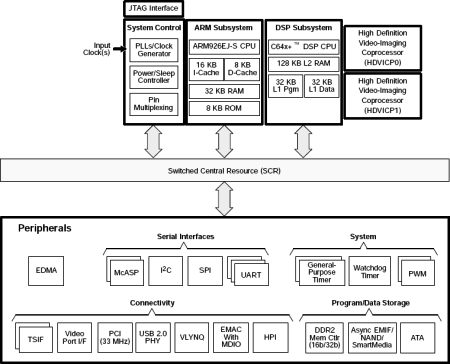DaVinci SoC optimized for 720p videoconferencing
Jun 1, 2010 — by Eric Brown — from the LinuxDevices Archive — 21 viewsTexas Instruments is prepping a version of its DM6467 DaVinci video processor optimized for videoconferencing. The single-chip VCE6467 Video Communications Engine integrates pre-installed software from RadVision on the ARM9-based, DSP-enabled DM6467 SoC, enabling two-way H.264 video at 720p quality running at 30 frames per second (fps), says the company.
The VCE6467 does not appear to apply any hardware changes to the underlying Texas Instruments (TI) DM6467 system-on-chip (SoC). By integrating the RadVision software, however, the SoC becomes a ready-made solution for a variety of two-way, live HD video communications applications, says TI. Applications are said to include videoconferencing, telemedicine, digital signage, and set-top boxes.
The VCE6467 enables 720p videoconferencing at 30fps using H.264 encoding and decoding with low-latency, says TI. Based on technology developed by RadVision's Technology Business Unit (TBU), the unnamed software appears to be related to the company's "Scopia" videoconferencing technology.
By offering the pre-installed and optimized RadVision software, the VCE6467 reduces software integration time by more than 10 times the number of man hours normally required, claims TI.
DM6467 background
The single-chip, 90nm-process DM6467 (formally called the TMS320DM6467) debuted in late 2007, combining an ARM926EJ-S RISC core and a TI C64 digital signal processor (DSP). The ARM9 core clocks to 584MHz, while the DSP runs at 297MHz.
The SoC also integrates an HD video/imaging coprocessor (HD-VICP), which is said to offer 3GHz of DSP processing power using dedicated 1080i H.264 accelerators. The HD-VICP can speed tasks like motion estimation/compensation, context adaptive coding/decoding, and loop filtering, says TI. Other on-chip hardware includes targeted video port interfaces and a conversion engine for accelerating downscaling, chroma sampling, and menu overlays.

TI DM6467 functional block diagram
(Click to enlarge)
Core DaVinci functions are tuned to the task of HD transcoding. For example, the DM6467 can translate between video codecs, bit rates, and resolutions as video is moved between different devices on home media networks, the chipmaker claims.
According to TI, the DM6476 can support up to four channels of MPEG4/H.264 MP D1 plus four secondary channels of MPEG4/H.264 MP CIF, or it can decode up to six channels of MPEG4/H.264 MP D1 video.
As with the DM6467, developers working with the VCE6467 can use a MontaVista Linux-based DM6467T EVM evaluation module, says TI.
Availability
The VCE6467 will be widely available in the third quarter, says Texas Instruments. In the meantime, customers can get started by downloading TI's VCE6467 trial software for use on the DM6467T EVM, which is available for $1,995, says the company. More information may be found here.
This article was originally published on LinuxDevices.com and has been donated to the open source community by QuinStreet Inc. Please visit LinuxToday.com for up-to-date news and articles about Linux and open source.